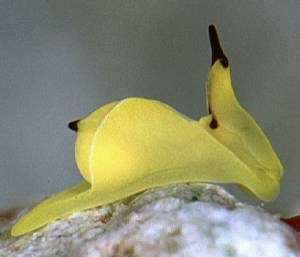
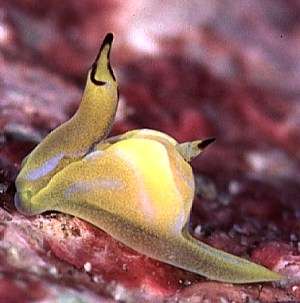
Siphopteron flavum
(Tokioka & Baba, 1964)
Order: CEPHALASPIDEA
Superfamily: PHILINOIDEA
Family: Gastropteridae
DISTRIBUTION
Japan, Guam, Hawaiian Islands.
PHOTO
Kerama Island, near Okinawa, Japan. UPPER: typical colour form. LOWER: possible colour variant. PHOTOS: Atsushi Ono.
See message below.
2-4mm long alive. Bright yellow with microscopic white specks. The siphonal crest is black and the edge of the upper part of the siphon can also be black. The posterior flagellum is black. They swim when disturbed. Gosliner distinguishes it from other species of the genus in having a terminal rather than a lateral flagellum on the posterior visceral hump.
References:
• Baba,K. & Tokioka,T (1965): Two more new species of Gastropteron from Japan, with further notes on G. flavum Tokioka & Baba (Gastropoda : Opisthobranchia). Publications of the Seto Marine Biological Laboratory 12(5), 363-377, Text-figs 1-8, Pl.25.
• Carlson,CH. & Hoff,PJ (1974): The Gastropteridae of Guam. with descriptions of four new species (Opisthobranchia: Cephalaspidea). Publications of the Seto Marine Biological Laboratory 21(5/6), 345-363. (Figs 1-13, Pl.10, figs 1-4.)
• Gosliner,T.M.(1989): Revision of the Gastropteridae (Opisthobranchia: Cephalaspidea) with descriptions of a new genus and six new species. The Veliger 32(4), 333-381.
• Ono, A. (1999) Opisthobranchs of Kerama Islands. Tokyo: TBS-Britannica Co.
• Tokioka,T. & Baba,K (1964): Four new species and a new genus of the family Gastropteridae from Japan (Gastropoda : Opisthobranchia). Publications of the Seto Marine Biological Laboratory 12(3), 201-229, Text-figs 1-15, Pls 10-13.
Rudman, W.B., 1999 (July 29) Siphopteron flavum (Tokioka & Baba, 1964). [In] Sea Slug Forum. Australian Museum, Sydney. Available from http://www.seaslugforum.net/find/siphflav
Related messages
Re: Siphopteron flavum feeding?
October 31, 2006
From: Ayumi Murakami
Concerning message #17771:
Hi Bill
Thank you for your advice.
I will keep studying living Siphopteron flavum and other sea slugs as well.
Ayumi Murakami
umiushi@masea.info
Ayumi Murakami, 2006 (Oct 31) Re: Siphopteron flavum feeding?. [Message in] Sea Slug Forum. Australian Museum, Sydney. Available from http://www.seaslugforum.net/find/17798Siphopteron flavum feeding?
September 8, 2006
From: Ayumi Murakami


Dear Bill
I'm sending you several pictures that I took on the 26th of August 2006 of what I think is Siphopteron flavum feeding. I saw 7 individuals on this day and three of them appeared to be feeding on the white sponge attatched to the seaweed.
Locality: Futoh, Izu Peninsula, 5m, Japan, Pacific ocean, 26 August 2006, on lock wall in beach Water Temp: 25C. Length: 5 mm. Photographer: Ayumi murakami.
Unfortunately, I can't identify the white sponge. What do you think it may be?
I hope these pictures are useful for your research.
Ayumi murakami.
umiushi@masea.info
Ayumi Murakami, 2006 (Sep 8) Siphopteron flavum feeding?. [Message in] Sea Slug Forum. Australian Museum, Sydney. Available from http://www.seaslugforum.net/find/17771
Dear Ayumi,
Thanks for these photos. I am afraid I can't tell whether the pale whitish lumps are small sponge colonies or not. They could be, or they could be the tubes of small polychaete worms encrusted with sand grains, or even small bryozoan colonies. All these animals can form lumps like this on branching algae.
We don't know what any gastropterid [Gastropteron, Siphopteron and Sagaminopteron ] feed on, but I think they are closely related to the carnivorous aglajids, philinids and scaphandrids, which all feed on particular prey, including polychaete worms, flatworms, sea slugs, and small bivalves. The shape of the teeth in gastropterids is very similar to that of philinids and scaphandrids so I am pretty sure they feed on something similar and are not sponge feeders.
Perhaps they are feeding on polychaete worms living in burrows or tubes? There certainly seem to be a couple of holes visible in your close-up photo. These Siphopteron are quite small so it is difficult to see precisely what they are doing in the field. Unfortunately though, I think that is the only way we are going to discover what they eat. All I can say is good luck and please keep looking.
Best wishes,
Bill Rudman
Re: Siphopteron flavum mating from Japan
May 12, 2003
From: Jun Imamoto
Dear Bill.
Thank you for the detailed commentary.
I agree with your opinion. I appreciate your comments very much.
Best Regards,
Jun Imamoto
http://umiushi.zive.net/
imamoto@wips.co.jp
Imamoto J., 2003 (May 12) Re: Siphopteron flavum mating from Japan. [Message in] Sea Slug Forum. Australian Museum, Sydney. Available from http://www.seaslugforum.net/find/9932Siphopteron flavum mating from Japan.
May 10, 2003
From: Jun Imamoto
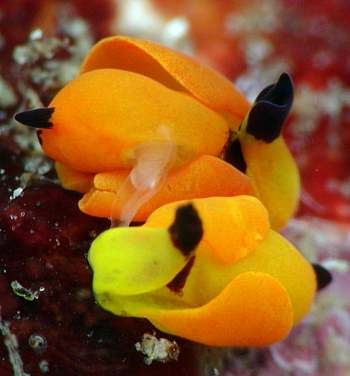
Dear Bill.
Fortunately I have recently observed mating in Siphopteron flavum. Each phallus appears to come out from the side of the visceral lump. Then it is inserted around the bottom part of the partner's head.
I have also sent you a photo of a yellow individual which wasn't copulating. As usual, both the yellow and orange types were found together. I am happy if these reports are useful for your research.
Futou, Izu Peninsula, Suruga Bay, Japan. Size: approx 4mm, Depth: 2m, Temp:19 C. 3 May 2003.
Best Regards,
Jun Imamoto
http://umiushi.zive.net/
imamoto@wips.co.jp
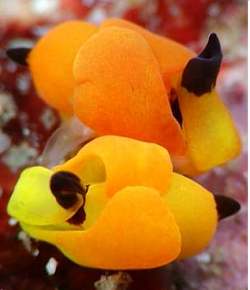
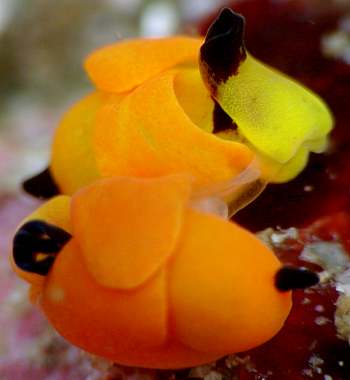
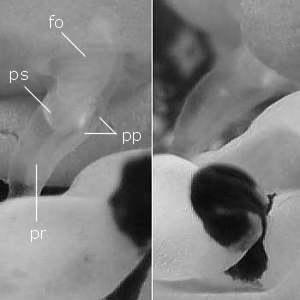
Dear Jun,
Thanks for these interesting photos. I don't know of any published information on mating in gastropterids. I think what is happening is the penis is coming out of the side of the head [see your lower right photo] and inserting in the female opening, which is on the right side of the body.
In most cephalaspideans the penis is physically separated from the rest of the reproductive system. The 'female' part of the reproductive system opens in the mantle cavity, or in cases like Siphopteron, where the mantle cavity is almost completely gone, it opens on the right side, where the last remains of the mantle cavity are found. In cephalaspids, and the anaspids [Sea Hares] there is an external groove from the female genital opening, which runs forward along the right side of the 'neck' to the opening to the penial sac on the right side of the head. The penis, prostate, and associated glands lie in this sac, inside the body except during mating, when the necessary parts are everted. The groove from the female opening carries the animal's sperm forward to the penis. During mating the penis is everted and inserted in the partner's female genital opening in the mantle cavity or on the right side of the body.
I would suspect what is happening in your photos is the penis everted from the right side of the head and is inserted in the female opening on the right side of the partners body below the visceral hump. It seems that part of the female system everts partially as well. In your upper photo the penial apparatus is narrow near the head and very wide near the other animal's visceral hump. You would expect it perhaps to taper the other way around, with the thin bit near the tip. However as Terry Gosliner's (1989) review shows, the penial complex in Siphopteron is quite complicated. As well as a tapering penial papilla there is an accsessory organ armed with spines. In fact he named one species S. quadrispinosum after the impressive set of 4 large spines it possesses. If I'm right I think the bits you can see in your photo are the female opening [fo],
and through the transparent wall of the penial sac, the muscular accessory organ with penial spines [ps]; the prostate gland [pr]; and either part of the penial papilla, or the sperm groove [pp].
Best wishes,
Bill Rudman
Siphopteron flavum - colour variation
May 10, 2003
From: Jun Imamoto

Dear Bill.
To accompany my message about Siphopteron flavum mating, here is a photo of an animal with the yellow colour form. Both the yellow and the orange are found together.
I am happy if these reports are useful for your research.
Futou, Izu Peninsula, Suruga bay, Japan.
size about: 4mm., Depth: 2m. 3 May 2003.
Best Regards,
Jun Imamoto
imamoto@wips.co.jp
Imamoto, J., 2003 (May 10) Siphopteron flavum - colour variation. [Message in] Sea Slug Forum. Australian Museum, Sydney. Available from http://www.seaslugforum.net/find/9895Thanks Jun,
The animals in your mating photos seem to show a nice variation betwen the yellow and orange forms. One has a quite yellow head shield but orange parapodia.
Best wishes,
Bill Rudman
Siphopteron flavum from Izu Peninsula, Japan
August 15, 2002
From: Haruo Kinoshita

Hi Bill
I want you to see a wonderful photo: This is Siphopteron flavum flying.
Date: 16-Jun-2000
Location: Syoubuzawa, Izu Peninsula, Japan
Depth: 8m
Length: 5mm
Water temperature: 19c
Photo: Hisako Yamada
Regards,
Haruo Kinoshita
kinoh@vesta.ocn.ne.jp
Kinoshita, H., 2002 (Aug 15) Siphopteron flavum from Izu Peninsula, Japan. [Message in] Sea Slug Forum. Australian Museum, Sydney. Available from http://www.seaslugforum.net/find/7750Dear Haruo,
This is indeed a wonderful photo. These gastropterids swim in such an irregular, jerky fashion, that photographing them is very difficult.
Best wishes,
Bill Rudman
Siphopteron flavum from Japan
August 4, 2001
From: Nishina Masayoshi

Dear Dr.Rudman,
Here are some photos of S. flavum (I guess) which were taken by Jun Imamoto.
Date: 30 June 2001
Place: Sokodo Hachijo, Japan
Depth: 6m
Size: 5mm
The bottom right photo was taken at original position.
Best Regards,
Nishina Masayoshi, Jun Imamoto
nishina@hpe15.wips.co.jp


Dear Nishina & Jun,
Thanks very much. Yes this is indeed S. flavum.
Best wishes,
Bill Rudman.
Siphopteron flavum? from Japan
March 1, 2000
From: Yasuhiro Shirai


Dear Bill,
Thank you for your reply about Siphopteron fuscum.
This time, I attach 2 photos which I thought were Siphopteron fuscum. But these animals are different color.
Could you please identify it for me?
Data:
Location: Shima Pref. Mie, Japan (Kii Peninsula, east coast)
Length: 10mm
Water temperature: 14C
Date Feb.2000
Depth: 2-3m
Crawling on rock or crawling on seaweed.
Best regards,
Yasuhiro Shirai
yasuhiro@e-net.or.jp
Yasuhiro Shirai, 2000 (Mar 1) Siphopteron flavum? from Japan. [Message in] Sea Slug Forum. Australian Museum, Sydney. Available from http://www.seaslugforum.net/find/1999Dear Yasuhiro,
Firstly, the animal I identified as S. fuscum is almost identical to the original description, so I am pretty sure that it is correctly identified. I have seen some published photos [See Atsushi Ono's Opisthobranchs of Kerama Islands in which the dark brown background colour can be a very pale yellowish brown.
In your photos, the short, blunt, posterior projection is very similar to that described for Siphopteron flavum (Tokioka & Baba, 1964). That animal was described as "bright chrome yellow, and minutely dotted with white. The posterior edge of cephalic shield is ivory black... as is posterior protuberance"
In a later publication (Baba & Tokioka, 1965) another specimen is described as lemon yellow and with reddish-purple rather than the black of first specimen. There is also a reddish purple spot on the posterior shield.
Carlson & Hoff (1974) report on 600 specimens they have observed in Guam and they describe the colour as yellow with bright white spots scattered over the dorsum and parapodia. In their specimens the parapodia are lined with dark brown as is the back edge of the funnel. the dorso-median crest and posterior protuberance are tipped in black.
If the Guam animals are the same as the Japanese specimens then the species is quite variable in colour.
Yasuhiro's animals have elements of both descriptions and they look a bit different from Atsushi Ono's photos at the top of this page. Any opinions or information on the colour variation, and the length of the posterior flagellum within S. flavum would be very welcome.
Best wishes,
Bill Rudman.
Siphopteron flavum from Kerama Island
July 30, 1999
From: Atsushi Ono


Dear Bill,
I have attached the photos you requested.
S. flavum is rare on Kerama Is, near Okinawa. I have seen a few individuals this 3 years. They are seen in winter season.
This animal is very small too, 3mm long.
The lower photo is in my book as a variation.
But I doubt it now. It has dull white patch on parapodia.
For a gastropterid feeding, I have never seen that. I will try to catch the scene in a photo when I find them. My acquaintance in Hatijyou Island (middle Japan) saw about 20 individuals of S. flavum together on a rock. There are short algae sparsely on that rock. I think their association is for breeding, not for feeding. And I asked him "Do you see a egg of S. flavum?"
He said "No, nothing."
Sincerely,
Atushi Ono
ononini@cosmos.ne.jp
Ono, A., 1999 (Jul 30) Siphopteron flavum from Kerama Island. [Message in] Sea Slug Forum. Australian Museum, Sydney. Available from http://www.seaslugforum.net/find/1135Dear Atsushi,
Thank you for the photos and the information.
I asked Atsushi if he would mind sending photos of Siphopteron flavum and Siphopteron tigrinum as his photos show the typical siphonal crest of species of Siphopteron so well. It certainly suggests that Siphopteron sp.1. and Siphopteron sp.2., which seem to lack this crest, are most possibly not Siphopteron.
I also asked Atsushi whether he has ever seen any sign of a gastropterid feeding. To me this is another great unsolved mystery. Perhaps like Chelidonura they are flatworm feeders. If anyone sees a feeding incident, please let us know!
Has anyone got any views on Atsushi's colour variant? Apart from the obvious colour differences, I wonder if the apparently right lateral position of the posterior flagellum is significant? Terry Gosliner states that S. flavum is peculiar in having a centrally placed flagellum, as can be seen in the upper photo of a typically coloured animal.
Best wishes,
Bill Rudman.
